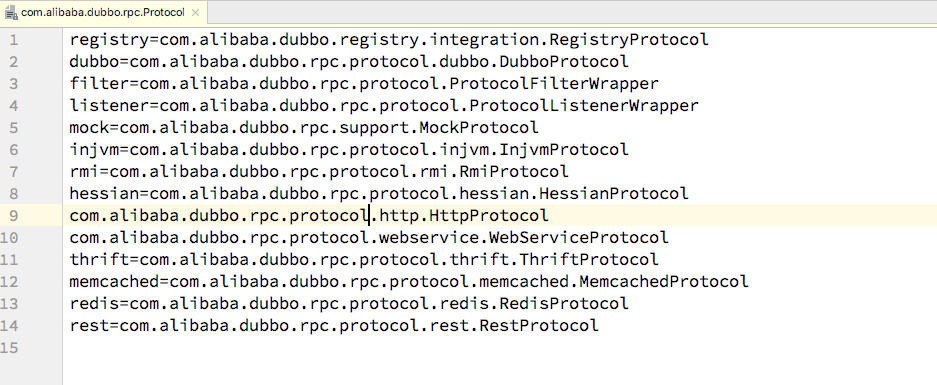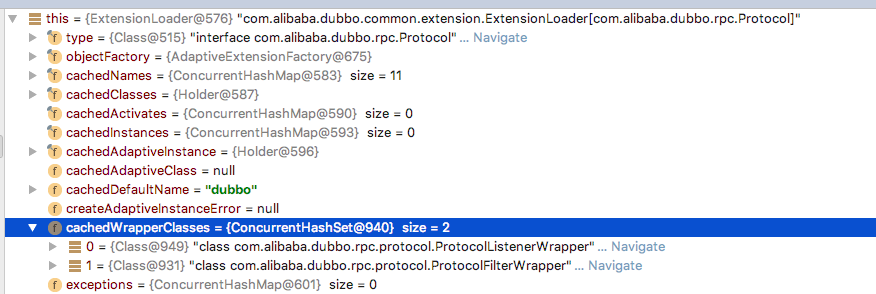Dubbo源码分析(一)Dubbo的扩展点机制
自己用Dubbo也有几年时间,一直没有读过Dubbo的源码,现在来读一读Dubbo的源码,分析一下Dubbo的几个核心,并写一个Dubbo的源码专题来记录一下学习过程,供大家参考,写的不好的地方,欢迎拍砖
专题分为以下几个部分:
- Dubbo源码分析(一)Dubbo的扩展点机制
- Dubbo源码分析(二)Dubbo服务发布Export
- Dubbo源码分析(三)Dubbo的服务引用Refer
- Dubbo源码分析(四)Dubbo调用链-消费端(集群容错机制)
- Dubbo源码分析(五)Dubbo调用链-服务端
- Dubbo源码分析(六)Dubbo通信的编码解码机制
- Dubbo框架的设计细节 (未完,待续)
PS:读源码前先掌握以下基础
- JDK的SPI
- Java多线程/线程池基础
- Javasissit基础(动态编译)
- Netty基础
- Zookeeper基础,zkClient客户端API
- 工厂模式,装饰模式,模板模式,单例模式,动态代理模式
- Spring的schema自定义扩展
- 序列化
PS:读源码前的建议
- 代码量很大,各个地方都有关联,慢慢读,不要着急,一遍不行就两遍,两遍不行就三遍,总有看懂的时候
- 带着问题去看,先想想这段代码的目的是什么,解决了什么问题
- 沿着一条主线读,不影响流程走向的代码可以略过
Dubbo的扩展点
为什么先读扩展点
之所以选择先从Dubbo的扩展点机制入手,因为Dubbo的整体架构设计上,都是通过扩展点去实现,先了解清楚这块内容,才能读懂代码。
Dubbo扩展点规范
- 如果要扩展自定义的SPI,可以在resources目录下配置三种目录,分别是:META-INF/dubbo/ 或者 META-INF/services/ 或者 META-INF/dubbo/internal/
- 文件名称和接口名称保持一致,文件内容为key=vaule的形式xxx=com.alibaba.xxx.XxxProtocol
- 举个栗子:如果我们要扩展Dubbo的一个协议,在META-INF/dubbo/com.alibaba.dubbo.rpc.Protocol这个文件里面增加一行自己的扩展:xxx=com.alibaba.xxx.XxxProtocol,在Dubbo的配置文件<dubbo:protocol name="xxx" />,这样就可以实现自定义的Dubbo协议
Dubbo的扩展点和JDK的SPI的区别
Dubbo的扩展点(Extension)在JDK的SPI思想的基础上做了一些改进:
读源码
- 先想想Dubbo的SPI的目的是什么?获取一个我们所需要的指定的对象
- 怎么获取呢?ExtensionLoader.getExtension(String name)
我们先从这段代码入手,这个代码的作用就是获取一个自适应的扩展类,我们看下这段代码的整个执行流程:
ExtensionLoader.getExtensionLoader(Protocol.class).getAdaptiveExtension(); 复制代码
getExtensionLoader方法中传入的了一个Protocol,我们看下Protocol长啥样
@SPI("dubbo")
public interface Protocol {
//获取缺省端口,当用户没有配置端口时使用。
int getDefaultPort();
// 暴露远程服务:<br>
@Adaptive
<T> Exporter<T> export(Invoker<T> invoker) throws RpcException;
//引用远程服务:<br>
@Adaptive
<T> Invoker<T> refer(Class<T> type, URL url) throws RpcException;
//释放协议:<br>
void destroy();
复制代码
这是一个协议接口,在类上有@SPI注解,有个默认值dubbo,在方法上有@Adaptive注解,这两个注解是什么作用呢?我们继续往下看getExtensionLoader方法:
public static <T> ExtensionLoader<T> getExtensionLoader(Class<T> type) {
·····
//先从缓存中取值,为null,则去new一个ExtensionLoader
ExtensionLoader<T> loader = (ExtensionLoader<T>) EXTENSION_LOADERS.get(type);
if (loader == null) {
EXTENSION_LOADERS.putIfAbsent(type, new ExtensionLoader<T>(type));
loader = (ExtensionLoader<T>) EXTENSION_LOADERS.get(type);
}
return loader;
}
复制代码
继续进入new ExtensionLoader(type)方法:
private ExtensionLoader(Class<?> type) {
this.type = type;
objectFactory = (type == ExtensionFactory.class ? null : ExtensionLoader.getExtensionLoader(ExtensionFactory.class).getAdaptiveExtension());
}
复制代码
给type变量赋值,objectFactory赋值,此时传入的type是Protcol,继续执行ExtensionLoader.getExtensionLoader(ExtensionFactory.class).getAdaptiveExtension()方法,这里我们分为两个步骤:
步骤一:ExtensionLoader.getExtensionLoader(ExtensionFactory.class),此时type为ExtensionFactory.class,这段代码我们得到一个ExtensionLoader实例,这个ExtensionLoader实例中,objetFactory为null, 步骤二:getAdaptiveExtension()方法,为cachedAdaptiveInstance赋值,我们来看这个方法:
public T getAdaptiveExtension() {
Object instance = cachedAdaptiveInstance.get();
if (instance == null) {
if (createAdaptiveInstanceError == null) {
synchronized (cachedAdaptiveInstance) {
instance = cachedAdaptiveInstance.get();
if (instance == null) {
try {
instance = createAdaptiveExtension();
cachedAdaptiveInstance.set(instance);
} catch (Throwable t) {
createAdaptiveInstanceError = t;
throw new IllegalStateException("fail to create adaptive instance: " + t.toString(), t);
}
}
}
} else {
throw new IllegalStateException("fail to create adaptive instance: " + createAdaptiveInstanceError.toString(), createAdaptiveInstanceError);
}
}
复制代码
双重检查锁判断缓存,如果没有则进入createAdaptiveExtension()方法,这个方法有两部分,一个是injectExtension,一个是getAdaptiveExtensionClass().newInstance()
private T createAdaptiveExtension() {
try {
return injectExtension((T) getAdaptiveExtensionClass().newInstance());
} catch (Exception e) {
throw new IllegalStateException("Can not create adaptive extenstion " + type + ", cause: " + e.getMessage(), e);
}
}
复制代码
先看getAdaptiveExtensionClass(),获取一个适配器扩展点的类
private Class<?> getAdaptiveExtensionClass() {
getExtensionClasses();
if (cachedAdaptiveClass != null) {
return cachedAdaptiveClass;
}
return cachedAdaptiveClass = createAdaptiveExtensionClass();
}
复制代码
这里我们进入getExtensionClasses()方法,双重检查锁判断,如果没有,继续
private Map<String, Class<?>> getExtensionClasses() {
Map<String, Class<?>> classes = cachedClasses.get();
if (classes == null) {
synchronized (cachedClasses) {
classes = cachedClasses.get();
if (classes == null) {
classes = loadExtensionClasses();
cachedClasses.set(classes);
}
}
}
return classes;
}
复制代码
进入loadExtensionClasses()方法
// 此方法已经getExtensionClasses方法同步过。
private Map<String, Class<?>> loadExtensionClasses() {
final SPI defaultAnnotation = type.getAnnotation(SPI.class);
if (defaultAnnotation != null) {
String value = defaultAnnotation.value();
if (value != null && (value = value.trim()).length() > 0) {
String[] names = NAME_SEPARATOR.split(value);
if (names.length > 1) {
throw new IllegalStateException("more than 1 default extension name on extension " + type.getName()
+ ": " + Arrays.toString(names));
}
if (names.length == 1) cachedDefaultName = names[0];
}
}
Map<String, Class<?>> extensionClasses = new HashMap<String, Class<?>>();
loadFile(extensionClasses, DUBBO_INTERNAL_DIRECTORY);
loadFile(extensionClasses, DUBBO_DIRECTORY);
loadFile(extensionClasses, SERVICES_DIRECTORY);
return extensionClasses;
}
复制代码
这里有个type.getAnnotation(SPI.class),这个type就是刚刚再初始化ExtensionLoader的时候传入的,我们先看type=ExtensionFactory.class的情况,ExtensionFactory接口类上有@SPI注解,但是value为空,然后三次调用loadFile方法,分别对应Dubbo扩展点的三个配置文件路径,在源码中我们可以找到ExtensionFactory对应的文件,


通过loadFile方法,最终extensionClasses返回SpringExtensionFactory和SpiExtensionFactory 缓存到cachedClasses中,为什么只返回了2个类呢,AdaptiveExtensionFactory为什么没有返回呢,因为在loadFile中AdaptiveExtensionFactory因为类上有@Adaptive注解,所以直接缓存到cachedAdaptiveClass中(此时,我们要思考,@Adaptive注解放在类上和放在方法上有什么区别),我们看下loadFile中的关键代码
private void loadFile(Map<String, Class<?>> extensionClasses, String dir) {
····
// 1.判断当前class类上面有没有Adaptive注解,如果有,则直接赋值给cachedAdaptiveClass
if (clazz.isAnnotationPresent(Adaptive.class)) {
if (cachedAdaptiveClass == null) {
cachedAdaptiveClass = clazz;
} else if (!cachedAdaptiveClass.equals(clazz)) {
throw new IllegalStateException("More than 1 adaptive class found: "
+ cachedAdaptiveClass.getClass().getName()
+ ", " + clazz.getClass().getName());
}
} else {
//2.如果没有类注解,那么判断该class中没有参数是type的构造方法,如果有,则把calss放入cachedWrapperClasses中
try {
clazz.getConstructor(type);
Set<Class<?>> wrappers = cachedWrapperClasses;
if (wrappers == null) {
cachedWrapperClasses = new ConcurrentHashSet<Class<?>>();
wrappers = cachedWrapperClasses;
}
wrappers.add(clazz);
} catch (NoSuchMethodException e) {
//3.判断是否有默认构造方法
clazz.getConstructor();
if (name == null || name.length() == 0) {
name = findAnnotationName(clazz);
if (name == null || name.length() == 0) {
if (clazz.getSimpleName().length() > type.getSimpleName().length()
&& clazz.getSimpleName().endsWith(type.getSimpleName())) {
name = clazz.getSimpleName().substring(0, clazz.getSimpleName().length() - type.getSimpleName().length()).toLowerCase();
} else {
throw new IllegalStateException("No such extension name for the class " + clazz.getName() + " in the config " + url);
}
}
}
String[] names = NAME_SEPARATOR.split(name);
if (names != null && names.length > 0) {
//4.判断class是否有@Activate注解,如果有,则放入cachedActivates
Activate activate = clazz.getAnnotation(Activate.class);
if (activate != null) {
cachedActivates.put(names[0], activate);
}
for (String n : names) {
//5.缓存calss到cachedNames中
if (!cachedNames.containsKey(clazz)) {
cachedNames.put(clazz, n);
}
Class<?> c = extensionClasses.get(n);
if (c == null) {
extensionClasses.put(n, clazz);
} else if (c != clazz) {
throw new IllegalStateException("Duplicate extension " + type.getName() + " name " + n + " on " + c.getName() + " and " + clazz.getName());
}
}
}
}
}
}
}
复制代码
至此,我们已经拿到了extensionClasses,并缓存到了cachedClasses中,回到getAdaptiveExtensionClass()方法中
private Class<?> getAdaptiveExtensionClass() {
getExtensionClasses();
if (cachedAdaptiveClass != null) {
return cachedAdaptiveClass;
}
return cachedAdaptiveClass = createAdaptiveExtensionClass();
}
复制代码
如果cachedAdaptiveClass不为空,那么就返回cachedAdaptiveClass,刚刚我们在loadFile()方法中讲过,@Adaptive注解在类上,那么就会缓存到cachedAdaptiveClass中,这个时候cachedAdaptiveClass有值,为AdaptiveExtensionFactory,所以这里直接返回AdaptiveExtensionFactory,继续返回createAdaptiveExtension()方法,刚刚我们只是走完了createAdaptiveExtension()方法中的一个部分,还有injectExtension方法,这个方法是干什么的,在type=ExtensionFactory.class流程中,这个方法的作用没有体现,先不看injectExtension,我们放在后面的流程去看,然后继续返回到getAdaptiveExtension方法中,把实例AdaptiveExtensionFactory缓存到cachedAdaptiveInstance中,继续返回到ExtensionLoader方法中
private ExtensionLoader(Class<?> type) {
this.type = type;
objectFactory = (type == ExtensionFactory.class ? null : ExtensionLoader.getExtensionLoader(ExtensionFactory.class).getAdaptiveExtension());
}
复制代码
这个时候,objectFactory已经有值了,就是AdaptiveExtensionFactory,继续返回getExtensionLoader方法
public static <T> ExtensionLoader<T> getExtensionLoader(Class<T> type) {
····
//EXTENSION_LOADERS判断是否有type,ConcurrentMap<Class<?>, ExtensionLoader<?>>
ExtensionLoader<T> loader = (ExtensionLoader<T>) EXTENSION_LOADERS.get(type);
if (loader == null) {
EXTENSION_LOADERS.putIfAbsent(type, new ExtensionLoader<T>(type));
loader = (ExtensionLoader<T>) EXTENSION_LOADERS.get(type);
}
return loader;
}
复制代码
我们把返回的ExtensionLoader实例缓存到EXTENSION_LOADERS中,此时type=Protocol
ExtensionLoader.getExtensionLoader(Protocol.class).getAdaptiveExtension(); 复制代码
至此,我们已经执行完了ExtensionLoader.getExtensionLoader(Protocol.class),得到了ExtensionLoader实例,继续执行getAdaptiveExtension()方法,这个方法在上面已经分析过了,我们再看下跟type=ExtensionFactory的时候有什么区别,先看下com.alibaba.dubbo.rpc.Protocol文件中有哪些扩展点(这个文件在源码中是分散的,可以在Dubbo的jar包中找,jar包中是合并的)

一共有13个扩展点,其中有2个Wrapper包装类,我们直接看loadFile方法,extensionClasses返回了11条记录

这个时候再看下当前内存中的数据

cachedNames中有11条,cachedWrapperClasses中有2条分别是ProtocolListenerWrapper 和 ProtocolFilterWrapper ,cachedClasses中有11条,回到getAdaptiveExtensionClass()方法中,我们在上面说过,Protocol的类上有 @SPI("dubbo")注解,export和refer上有@Adaptive注解,所以此时cachedAdaptiveClass是null, ,进入createAdaptiveExtensionClass()方法,这个方法的目的是自动生成和编译一个动态代理适配器类,名字叫Protocol$Adaptive, 这里又用到了一个Compile扩展点,可以看到,这里用到了ExtensionLoader.getExtensionLoader(com.alibaba.dubbo.common.compiler.Compiler.class).getAdaptiveExtension(),有木有很熟悉,这里得到一个AdaptiveCompiler(因为AdaptiveCompiler类上有@Adaptive注解)
private Class<?> createAdaptiveExtensionClass() {
//生成字节码文件
String code = createAdaptiveExtensionClassCode();
//获得类加载器
ClassLoader classLoader = findClassLoader();
com.alibaba.dubbo.common.compiler.Compiler compiler =
ExtensionLoader.getExtensionLoader(com.alibaba.dubbo.common.compiler.Compiler.class).getAdaptiveExtension();
//动态编译
return compiler.compile(code, classLoader);
}
复制代码
执行compiler.compile(code, classLoader),先看下AdaptiveCompiler类
@Adaptive
public class AdaptiveCompiler implements Compiler {
private static volatile String DEFAULT_COMPILER;
public static void setDefaultCompiler(String compiler) {
DEFAULT_COMPILER = compiler;
}
public Class<?> compile(String code, ClassLoader classLoader) {
Compiler compiler;
ExtensionLoader<Compiler> loader = ExtensionLoader.getExtensionLoader(Compiler.class);
String name = DEFAULT_COMPILER; // copy reference
if (name != null && name.length() > 0) {
compiler = loader.getExtension(name);
} else {
compiler = loader.getDefaultExtension();
}
return compiler.compile(code, classLoader);
}
}
复制代码
这里的DEFAULT_COMPILER值为JavassistCompiler,执行loader.getExtension(name),这个方法这里暂时不展开,结果是得到JavassistCompiler实例,这里是一个装饰模式的设计,最终调用JavassistCompiler.compile()方法得到Protocol$Adpative,
回到我们最初的代码的入口
ExtensionLoader.getExtensionLoader(Protocol.class).getAdaptiveExtension(); 复制代码
这句代码就最终的返回结果就是Protocol$Adpative,我们把这个代理类拿出来看一下
package com.alibaba.dubbo.rpc;
import com.alibaba.dubbo.common.extension.ExtensionLoader;
public class Protocol$Adpative implements com.alibaba.dubbo.rpc.Protocol {
public void destroy() {throw new UnsupportedOperationException("method public abstract void com.alibaba.dubbo.rpc.Protocol.destroy() of interface com.alibaba.dubbo.rpc.Protocol is not adaptive method!");
}
public int getDefaultPort() {throw new UnsupportedOperationException("method public abstract int com.alibaba.dubbo.rpc.Protocol.getDefaultPort() of interface com.alibaba.dubbo.rpc.Protocol is not adaptive method!");
}
public com.alibaba.dubbo.rpc.Exporter export(com.alibaba.dubbo.rpc.Invoker arg0) throws com.alibaba.dubbo.rpc.RpcException {
if (arg0 == null) throw new IllegalArgumentException("com.alibaba.dubbo.rpc.Invoker argument == null");
if (arg0.getUrl() == null) throw new IllegalArgumentException("com.alibaba.dubbo.rpc.Invoker argument getUrl() == null");com.alibaba.dubbo.common.URL url = arg0.getUrl();
String extName = ( url.getProtocol() == null ? "dubbo" : url.getProtocol() );
if(extName == null) throw new IllegalStateException("Fail to get extension(com.alibaba.dubbo.rpc.Protocol) name from url(" + url.toString() + ") use keys([protocol])");
com.alibaba.dubbo.rpc.Protocol extension = (com.alibaba.dubbo.rpc.Protocol)ExtensionLoader.getExtensionLoader(com.alibaba.dubbo.rpc.Protocol.class).getExtension(extName);
return extension.export(arg0);
}
public com.alibaba.dubbo.rpc.Invoker refer(java.lang.Class arg0, com.alibaba.dubbo.common.URL arg1) throws com.alibaba.dubbo.rpc.RpcException {
if (arg1 == null) throw new IllegalArgumentException("url == null");
com.alibaba.dubbo.common.URL url = arg1;
String extName = ( url.getProtocol() == null ? "dubbo" : url.getProtocol() );
if(extName == null) throw new IllegalStateException("Fail to get extension(com.alibaba.dubbo.rpc.Protocol) name from url(" + url.toString() + ") use keys([protocol])");
com.alibaba.dubbo.rpc.Protocol extension = (com.alibaba.dubbo.rpc.Protocol)ExtensionLoader.getExtensionLoader(com.alibaba.dubbo.rpc.Protocol.class).getExtension(extName);
return extension.refer(arg0, arg1);
}
}
复制代码
这个时候如果执行Protocol$Adpative.export方法,我们看下这个适配器代理类里面的export()方法,通过url来获取extName,所以Dubbo是基于URL来驱动的, 看到Protocol extension = (Protocol)ExtensionLoader.getExtensionLoader(Protocol.class).getExtension(extName)这个方法,这个方法是不是又又又很熟悉,接下来我们来分析getExtension(String name)方法,假设此时extName=dubbo
public T getExtension(String name) {
if (name == null || name.length() == 0)
throw new IllegalArgumentException("Extension name == null");
if ("true".equals(name)) {
return getDefaultExtension();
}
Holder<Object> holder = cachedInstances.get(name);
if (holder == null) {
cachedInstances.putIfAbsent(name, new Holder<Object>());
holder = cachedInstances.get(name);
}
Object instance = holder.get();
if (instance == null) {
synchronized (holder) {
instance = holder.get();
if (instance == null) {
instance = createExtension(name);
holder.set(instance);
}
}
}
return (T) instance;
}
复制代码
进入createExtension()方法
private T createExtension(String name) {
//1.通过name获取ExtensionClasses,此时为DubboProtocol
Class<?> clazz = getExtensionClasses().get(name);
if (clazz == null) {
throw findException(name);
}
try {
//2.获取DubboProtocol实例
T instance = (T) EXTENSION_INSTANCES.get(clazz);
if (instance == null) {
EXTENSION_INSTANCES.putIfAbsent(clazz, (T) clazz.newInstance());
instance = (T) EXTENSION_INSTANCES.get(clazz);
}
//3.dubbo的IOC反转控制,就是从spi和spring里面提取对象赋值。
injectExtension(instance);
Set<Class<?>> wrapperClasses = cachedWrapperClasses;
if (wrapperClasses != null && wrapperClasses.size() > 0) {
for (Class<?> wrapperClass : wrapperClasses) {
//4.如果是包装类
instance = injectExtension((T) wrapperClass.getConstructor(type).newInstance(instance));
}
}
return instance;
} catch (Throwable t) {
throw new IllegalStateException("Extension instance(name: " + name + ", class: " +
type + ") could not be instantiated: " + t.getMessage(), t);
}
}
复制代码
第三步injectExtension(instance),看一下代码:
private T injectExtension(T instance) {
try {
if (objectFactory != null) {
//1.拿到所有的方法
for (Method method : instance.getClass().getMethods()) {
//判断是否是set方法
if (method.getName().startsWith("set")
&& method.getParameterTypes().length == 1
&& Modifier.isPublic(method.getModifiers())) {
Class<?> pt = method.getParameterTypes()[0];
try {
String property = method.getName().length() > 3 ? method.getName().substring(3, 4).toLowerCase() + method.getName().substring(4) : "";
//从objectFactory中获取所需要注入的实例
Object object = objectFactory.getExtension(pt, property);
if (object != null) {
method.invoke(instance, object);
}
} catch (Exception e) {
logger.error("fail to inject via method " + method.getName()
+ " of interface " + type.getName() + ": " + e.getMessage(), e);
}
}
}
}
} catch (Exception e) {
logger.error(e.getMessage(), e);
}
return instance;
}
复制代码
这个方法就是Dubbo完成依赖注入的地方,到这里关于Dubbo的扩展点机制的代码就分析完成了。
总结
- 为什么要设计Adaptive?
Adaptive设计的目的是为了识别固定已知类和扩展未知类 - 注解在类上和注解在方法上的区别?
1.注解在类上:代表人工实现,实现一个装饰类(设计模式中的装饰模式),它主要作用于固定已知类, 目前整个系统只有2个,AdaptiveCompiler、AdaptiveExtensionFactory。- 为什么AdaptiveCompiler这个类是固定已知的?因为整个框架仅支持Javassist和JdkCompiler。
- 为什么AdaptiveExtensionFactory这个类是固定已知的?因为整个框架仅支持2个objFactory,一个是spi,另一个是spring
2.注解在方法上:代表自动生成和编译一个动态的Adpative类,它主要是用于SPI,因为spi的类是不固定、未知的扩展类,所以设计了动态XXX$Adaptive类. 例如 Protocol的spi类有 injvm dubbo registry filter listener等等 很多扩展未知类, 它设计了Protocol$Adaptive的类,通过ExtensionLoader.getExtensionLoader(Protocol.class).getExtension(spi类);来提取对象
- 本文标签: 锁 适配器 ssl src find API cache key 字节码 同步 端口 zookeeper message 时间 id volatile 缓存 java lib tar 数据 自动生成 实例 JVM dubbo 源码 集群 线程池 代码 服务端 参数 类加载器 spring client UI ioc App equals 总结 协议 cat ACE 多线程 AOP list synchronized 目录 schema https 配置 Service CTO HashMap final HashSet 编译 线程 http Netty IO value 构造方法 自适应 struct map Property 设计模式 架构设计
- 版权声明: 本文为互联网转载文章,出处已在文章中说明(部分除外)。如果侵权,请联系本站长删除,谢谢。
- 本文海报: 生成海报一 生成海报二











![[HBLOG]公众号](https://www.liuhaihua.cn/img/qrcode_gzh.jpg)

